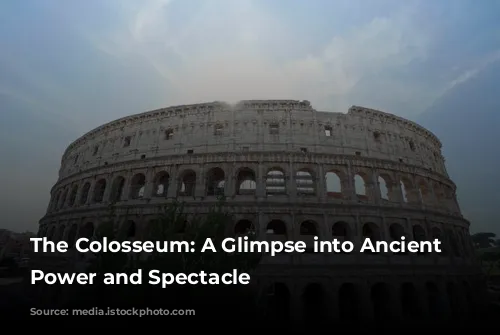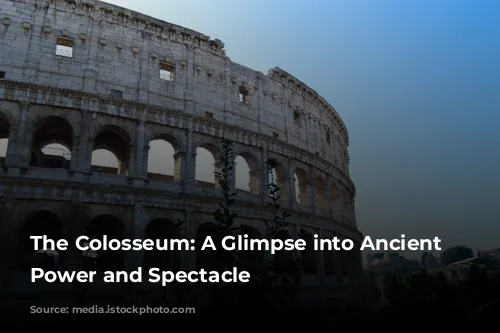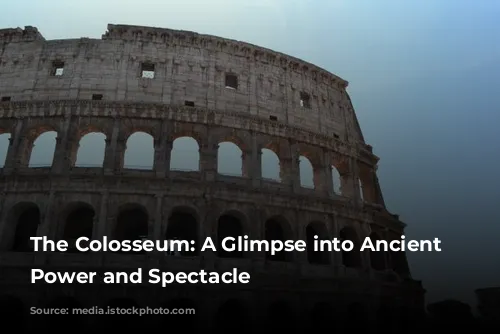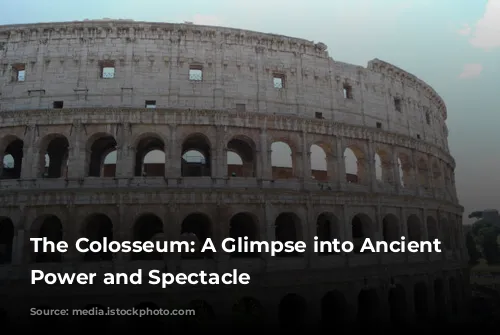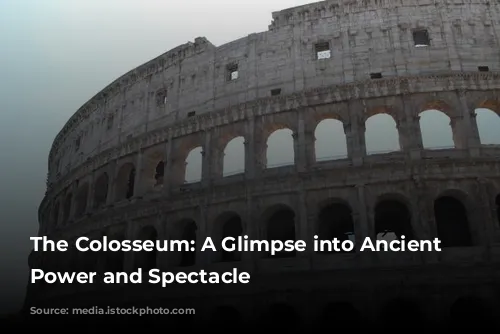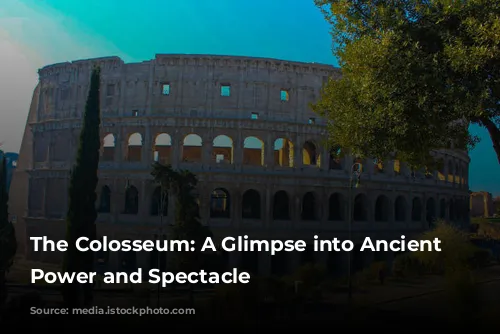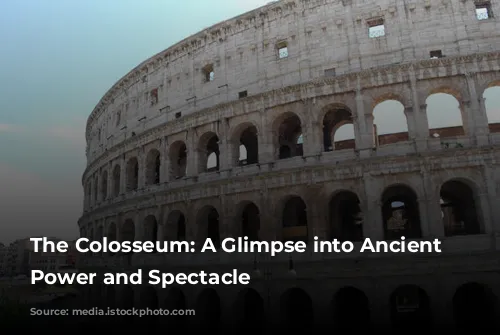The Colosseum, also known as the Flavian Amphitheatre, stands as a towering testament to the grandeur of the Roman Empire. This monumental structure, the largest amphitheatre in the Roman world, was commissioned by Emperor Vespasian of the Flavian dynasty and inaugurated by his son Titus in 80 AD.
The Colosseum’s opening ceremony was a spectacle of unprecedented scale, lasting a staggering one hundred days. During this time, the Roman people were treated to an array of thrilling events, including gladiatorial combats, animal hunts, and even naval battles known as naumachias. These naumachias were staged by flooding the arena with water, creating a stage for spectacular naval re-enactments.
The Colosseum: A Name With History
But why is this magnificent structure universally known as the Colosseum? The name first appeared in a prophecy by the Venerable Bede, a medieval monk. He famously declared, “Rome will exist as long as the Colosseum does; when the Colosseum falls so will Rome; when Rome falls so will the world.”
The origin of the name is believed to be linked to the colossal statue of Emperor Nero, known as “the Colossus,” which stood near the amphitheatre. This massive statue, towering 35 meters high, has since been destroyed, but its legacy lives on in the name of the Colosseum.
A Marvel of Roman Engineering
The Roman Colosseum is a breathtaking example of Roman architectural ingenuity. Imagine the structure, once gleaming white, completely clad in stunning travertine stone slabs. Its elliptical shape allowed for maximum seating capacity, and its four levels featured eighty arches each. The arches on the second and third levels were adorned with magnificent statues, further enhancing the Colosseum’s aesthetic splendor.
The Romans were renowned for their mastery of the arch, an architectural element that allowed them to distribute the weight of massive structures effectively. The Colosseum itself is a prime example of this architectural expertise, a testament to the Romans’ mastery of construction.
The Colosseum: A Witness to Time
Today, the Colosseum stands as a skeletal reminder of its past glory. The outer brick wall, once complete, is now missing three-fifths of its original structure. During the Middle Ages, when the Colosseum fell into disuse, it was plundered for its valuable materials. Marble, lead, and iron were salvaged and used to construct other structures, including Barberini Palace, Piazza Venezia, and even St. Peter’s Basilica.
The holes still visible in many of the Colosseum’s columns are a testament to this plundering, the remnants of the lead and iron used for nails within the marble blocks.
A Stadium for the Masses
The Colosseum could accommodate up to 70,000 spectators, offering them a breathtaking view of the arena. The tiered seating was meticulously designed to ensure perfect visibility from every seat. Entry was free for all Roman citizens, but seating was strictly divided based on social status, similar to today’s theatres. The upper tiers were reserved for the common people, with separate sections for men and women. As one descended towards the arena, the social status of the spectators increased. The front row was reserved for senators, Vestal Virgins, priests, and, of course, the emperor.
Like modern sports stadiums, the Colosseum provided spectators with protection from the sun thanks to its ingenious roof system, known as the Velarium. This enormous linen tarpaulin was hung by ropes, winches, and wooden poles that encircled the top of the outer wall. It required a team of one hundred sailors from the Imperial fleet to maneuver the Velarium, working in perfect synchrony to the beat of a drum.
The Colosseum: A Stage for Spectacle
Upon entering the Colosseum, one would have been greeted by the vast arena, the stage for the spectacular events that took place within its walls. The original floor, made of brick and wood, has long since disappeared, revealing the cellars below. These cellars housed equipment used for the preparation and execution of the games, a glimpse into the mechanics of the ancient world’s most impressive stage.
The two underground floors housed lifts and hoists with their counterweights, the remnants of which are still visible today. These were the special effects of their time, used to raise animals and gladiators from below, creating spectacular entrances into the arena with a burst of white dust.
Gladiators: The Colosseum’s Stars
The Colosseum played host to a variety of events, each carefully planned and executed. The mornings were typically dedicated to Venationes, contests pitting exotic animals against each other, or against human opponents. These events sometimes served as a form of public execution, with individuals left at the mercy of ferocious beasts.
The Silvae, another popular event, was particularly impressive. Painters and set designers recreated forest scenes, complete with trees, bushes, and animals. These events were not necessarily about killing the animals, but rather about creating a sense of wonder and spectacle.
However, the event that captivated the Roman audience most was the gladiatorial combat. The gladiators entered the arena from an underground passageway connected to their barracks, the Ludus Magnus, and were greeted by the crowd with cheers and admiration. After a ceremonial lap around the arena, the gladiators would pay homage to the Emperor, saluting him with the famous words “Ave Cesare morituri te salutant” (Hail Caesar, those who are about to die salute you).
The World of Gladiators
The term gladiator comes from “Gladius,” the short sword used by Roman legionaries. These warriors were not always forced into combat. Many were prisoners of war given the choice between slavery and fighting in the arena. They fought for a limited time, earning their freedom after saving a certain amount of money.
Other gladiators were simply impoverished individuals seeking fame and fortune. The profession offered not only financial reward but also immense popularity, particularly among women, who would pay large sums for the privilege of a night with a victorious gladiator.
There were twelve different types of gladiators, each with their own unique weapon and fighting style. The Retiarius, armed with a net, trident, and knife, was one such type, while others fought with a shield and sickle or wore crested helmets and strong armor. The pairings of gladiators in each fight were chosen for their dramatic potential, adding to the excitement of the event.
The Colosseum: A Legacy of Spectacle
The Colosseum’s legacy extends far beyond its impressive structure. It is a monument to the Roman fascination with spectacle and brutality, a glimpse into the social fabric of a society that found entertainment in the thrill of combat and the allure of the exotic.
While the Colosseum’s events might seem barbaric by today’s standards, they were an integral part of Roman life. They offered a sense of community, a shared experience that united citizens and their leader. They provided distraction from the complexities of political life, offering a thrilling escape into a world of action and spectacle.
As Charles Dickens aptly put it, a visit to the Colosseum is like “seeing the ghost of old Rome floating over the places its people walk in.” It is a reminder of a powerful empire, a society that built grand structures and reveled in extraordinary displays of power and entertainment. The Colosseum, with its scarred walls and echoes of past battles, stands as a timeless testament to the enduring power of the Roman legacy.
